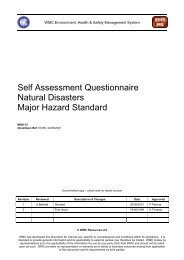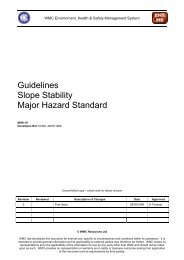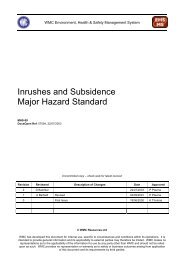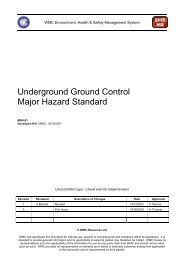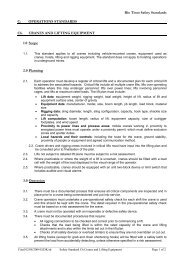Aviation Major Hazard Standard - MIRMgate
Aviation Major Hazard Standard - MIRMgate
Aviation Major Hazard Standard - MIRMgate
Create successful ePaper yourself
Turn your PDF publications into a flip-book with our unique Google optimized e-Paper software.
<strong>Major</strong> <strong>Hazard</strong> <strong>Standard</strong><br />
MHS 03 - <strong>Aviation</strong> <strong>Standard</strong> documen Revision 3<br />
issued 20 August 2001<br />
** Uncontrolled copy. Use latest revision **<br />
• separation of fuel facilities from the landing area<br />
• elimination of projections adjacent to the landing<br />
area which might hazard under-slung loads<br />
Where there is a requirement for a helicopter<br />
(particularly skid fitted) to shut down engines at a<br />
remote or confined landing area, a contingency plan<br />
should be made to provide for access to the location<br />
by another helicopter in the event the first helicopter<br />
becomes unserviceable.<br />
Alternative landing areas should be identified that<br />
are available in the event of an emergency.<br />
Contingency plans should be prepared<br />
Hot Refueling<br />
Hot or rotors running refueling of helicopters shall<br />
not be permitted unless there is an over-riding<br />
operational necessity to do so.<br />
Where hot refueling is required by operational<br />
necessity:<br />
• detailed written procedures for the operation<br />
shall be in place<br />
• the procedures shall be specific to the type of<br />
helicopter<br />
• personnel involved in the operation shall have<br />
received formal training in the refueling<br />
procedures<br />
Load Handling Procedures<br />
The operating procedures shall describe the load<br />
management and handling procedures to be used in<br />
the operation. The responsibilities of the load<br />
handling ground crew and the flight crew should be<br />
specified. The pilot in command of the helicopter<br />
shall have responsibility for the acceptance of the<br />
load handling procedures adopted for the operation.<br />
The procedures should identify the hazards involved<br />
in the load handling operation and the controls<br />
required to be in place to mitigate the potential for<br />
accidents.<br />
Load Planning<br />
A load plan should be prepared for the operation by<br />
the flight crew and the load handling ground crew.<br />
All items to be transported shall be weighed and<br />
marked. Loads should be pre-slung wherever<br />
possible. Loads shall not exceed those approved for<br />
the type of helicopter used.<br />
Load Handling Crew<br />
When picking up external loads, the helicopter<br />
should be attended by a load handling crew<br />
comprising :<br />
• loadmaster - solely responsible for<br />
communicating with the pilot and directing the<br />
helicopter over the load. Communication<br />
between the loadmaster and the pilot shall be by<br />
both radio and hand signals.<br />
• hook operator - to connect the load to the<br />
helicopter’s cargo hook<br />
When dropping loads, only the loadmaster is<br />
required to attend the helicopter. Other personnel<br />
should be kept clear of the drop area.<br />
Only personnel who have received training in load<br />
handling procedures shall form the load handling<br />
crew.<br />
Loadmasters shall wear clothing to distinguish them<br />
from other personnel on the ground and be readily<br />
identifiable to helicopter pilots.<br />
Lifting Equipment<br />
Lifting equipment shall be:<br />
• provided with valid, current test certificates<br />
• dedicated to helicopter external load operations<br />
and kept separate from other lifting gear<br />
• inspected and maintained on a regular basis with<br />
records kept of its maintenance<br />
• rigged with a swivel in the line<br />
All items in the load lifting assembly shall have a<br />
breaking strain of at least four times the weight of<br />
the heaviest load to be lifted.<br />
Helicopter cargo hook release mechanisms should<br />
be tested daily.<br />
Dangerous Goods<br />
Items classed as Dangerous Goods may be carried as<br />
external loads in accordance with the following<br />
guidelines:<br />
• explosives and detonators shall not be transported<br />
on the same flight;<br />
• explosives should be carried as external loads<br />
wherever possible;<br />
• detonators shall be carried only as external loads<br />
but may be combined with compatible or inert<br />
goods;<br />
• the operator shall have approval to carry<br />
dangerous goods.<br />
Personal Protective Equipment<br />
Personnel working around helicopters engaged in<br />
external load operations shall wear protection<br />
against possible hazards (dust, small objects)<br />
generated by rotor down-wash, noise, or accidents<br />
involving loads.<br />
SAF-MHS-03 Rev. 03 Docs: 55221 Issued: 20/08/01 Page 27 of 29







